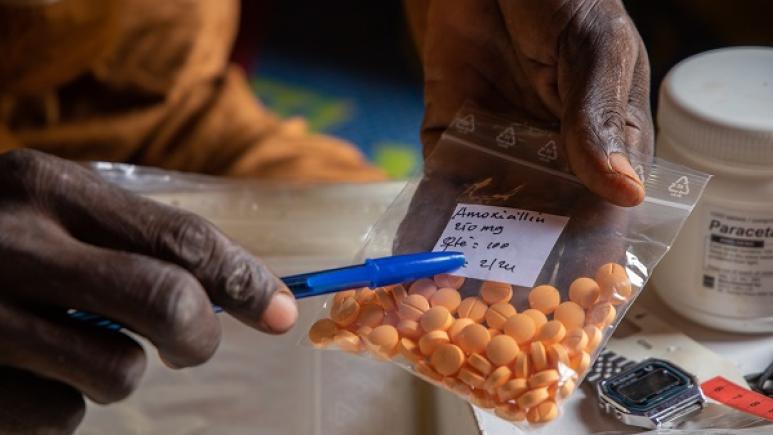The challenges of appropriate antibiotic use
Throughout the 20th century, antibiotics have helped to reduce the incidence of bacterial diseases. The corollary of this remarkable effectiveness has been a massive increase in the use of antibiotics, sometimes in inappropriate ways. This misuse - treatments that are too short, too long or inappropriate - is one of the factors that encourage the emergence of antimicrobial resistance. The African continent is not being spared this public health problem, and Western sub-Saharan Africa is even considered one of the worst affected regions, with 27.3 deaths per 100,000 people attributable to antimicrobial resistance (1). Serious antibiotic-resistant infections are responsible for a high mortality rate among children, particularly in countries with limited resources.
Antibiotic prescribing practices in Niger and Uganda
How do the healthcare workers prescribe antibiotics to children? To find our, epidemiologists from Epicentre conducted a retrospective mixed-method study - just published in Antimicrobial Resistance & Infection Control - among healthcare workers in Niger and Uganda.
“We collected data from 8 hospitals and health centres in Uganda and Niger, explains Grace Mambula, head of pharmacovigilance at Epicentre. The quantitative data was collected retrospectively on a systematic sample of consultations over a one-year period to avoid any seasonal impact. A total of 1,622 children in Uganda and 660 children in Niger who had received at least one antibiotic were included in the study. In addition, interviews and focus groups with healthcare staff and caregivers of children were conducted."
The first finding is fairly positive, since 78.2% of the antibiotics prescribed in Niger and 68% in Uganda belong to the "Access" category of the WHO "AWaRe" classification, i.e. the group of antibiotics least exposed to the risk of resistance. The remainder of the antibiotics prescribed belonged to the "Watch" category, i.e. antibiotics recommended for specific and limited indications, and none belonged to the 3rd category known as "Reserve", which corresponds to antibiotics that should only be used as a last resort, when all other antibiotics have failed.
“These results go beyond the WHO's recommendations that by 2023 at least 60% of all antibiotics consumed should come from the "Access" category, explains Grace Mambula But this has to be taken into context, because according to the health care workers interviewed, prescriptions are not always respected and used appropriately.”
Challenges in prescribing
Problems with the availability of antibiotics in hospital stocks can lead prescribers to change antibiotics during the course of treatment or require parents to buy them at their own expense outside hospital, which can lead them to resort to another, less expensive antibiotic, or even to shorten the course of treatment. As a doctor in Niamey, Niger, reported in the publication:
" Some mothers can't pay, you can give her a prescription, she will keep it up to three days without buying the products. [...] She will tell you that she doesn't even have enough money to buy food. This is our biggest problem; you start antibiotic therapy after 2 days, and you stop".
The qualitative study also shows that antibiotic prescriptions are determined more by the availability of antibiotics and their ease of administration than by therapeutic rationale.
"For example, when administration requires the intervention of healthcare staff, the use of antibiotics that are easier to administer in terms of frequency of administration are observed as a result of staff shortages," explains Grace Mambula.
On the other hand, there is a real demand from the healthcare staff and parents interviewed for more regulation and more precise recommendations on the use of antibiotics at all levels. Antibiotics are now available almost everywhere, particularly on the open market, which encourages self-medication and therefore misuse of antibiotics. Parents are unaware of the risks associated with these medicines, which are stored in poor conditions and of uncertain quality.
Mainly empirical prescriptions
Most prescriptions are made empirically, without using microbiological assays, which are rarely accessible or too expensive. Health workers in both countries recognize their lack of knowledge about antibiotic stewardship. This contributes to the rise in broad-spectrum antibiotic prescriptions, with the addition of a new antibiotic in the event of failure, without considering the risks in terms of resistance. An additional phenomenon is emerging in Uganda: the pressure exerted by medical representatives. They compensate for the lack of institutional information on antibiotics on the market, but in return influence prescribers in their choice.
Recommendations for improvement
According to the healthcare staff and parents interviewed, what is needed is to facilitate access and availability of antibiotics in hospitals, where for budgetary reasons or poor stock management, they are not always available when needed. There is also a need to step up training for healthcare professionals on the proper use of antibiotics and the risks of inappropriate use, as well as giving them the means to make accurate diagnoses and thus the right prescription choices. Formulations that are better suited to children also need to be developed to make it easier for them to take the medication and thus adhere to treatment.
"There is an urgent need for action at all levels to improve the rationality of antibiotic prescribing, and to take care not to enter into a vicious circle. In the past, the choice of antibiotics was fairly limited, but the rise in resistance has led to the introduction of new treatments which take a very long time to develop. Once these new antibiotics go onto the market, their inappropriate use increases the potential for the development of antimicrobial resistance," concludes Grace Mambula.
* The Global Antibiotic Research and Development Partnership (GARDP) is a Swiss not-for-profit organization developing new treatments for drug-resistant infections that pose the greatest threat to health. GARDP was created by the World Health Organization and the Drugs for Neglected Diseases initiative in 2016 and legally founded in 2018 to ensure that everyone who needs antibiotics receives effective and affordable treatment.”
- Global burden of bacterial antimicrobial resistance in 2019: a systematic analysis. The lancet 2022 Feb 12;399(10325):629-655. doi: 10.1016/S0140-6736(21)02724-0. Epub 2022 Jan 19.









